Search Results for Tag: science
Trump’s alternative reality? No warming, cool oceans, intact coral

Melting or not? (I.Quaile, Greenland)
“Irene, have you heard the news? Looks like Trump has pulled out of the Paris Agreement.” While the US President kept the suspense up until Thursday night – has he, hasn’t he, will he, won’t he -I struggled to reconcile his action with what I was hearing from a wide spectrum of highly intelligent people with decades of research and experience to their credit.
I was in Kiel this week, on Germany’s Baltic coast, attending a working meeting of the scientists involved in BIOACID, a national German programme (supported by the BMBF, Federal Ministry of Education and Research) to investigate the “Biological Impacts of Ocean Acidification”. It has almost run its course, eight years of research in the bag.
And what I was hearing did nothing to allay my concern about the impacts of our greenhouse gas emissions. We are rapidly and undeniably changing the planet we live on – land and sea. And that applies particularly to the Arctic.

GEOMAR’s research vessel Alkor in Kiel getting ready for her next trip (Pic:.I.Quaile)
The scientific evidence
Can President Trump really fail to see the dangers of our human interference? Is he really oblivious to what climate change is doing to the ocean that covers 70 percent of the surface of our planet?
Maybe he lives in a parallel universe, where alternative facts prevail.
Back in 2010, I was able to witness the work of some of the scientists assembled in Kiel this week at first hand, as they lowered mesocosms, a kind of giant test tubes, into the Arctic Ocean off the coast of Svalbard. The aim was to find out how the life forms in the water would react to increasing acidification of their environment, as our greenhouse gas emissions result in more and more CO2 being absorbed into the ocean.
Drawing the threads together

Ulf Riebesell with team members deploying experiments at Svalbard (Pic.I.Quaile)
Ulf Riebesell is Professor of Professor of Biological Oceanography at, GEOMAR, the Helmholtz Centre for Ocean Research in Kiel, and the coordinator of BIOACID.
When I first met him, he was kitted out in survival gear, supervising the transport and deployment of the mesocosms from Germany up to the Svalbard archipelago. He doesn’t need the cold-weather gear this week, in a summery Kiel, where he gathered representatives of the different working groups involved in the German project to draw some threads together as the project approaches its conclusion in November.
Good timing. The results will be ready to hand to the delegates attending this year’s UN climate extravaganza, COP23, in Bonn. Another key piece in the jigsaw puzzle of how climate change is affecting the world we live in and will determine the future of coming generations.
All creatures great and small
The scientists assembled represent a wide range of expertise. From the tiniest of microbes through algae, corals, fish and the myriad organisms that live in our seas- they have been trying to find out what happens when living conditions change for our fellow planetary residents – and how all this affects an ever-increasing population of humans and the complex societies we live in.
The ocean is changing at an unprecedented rate. It is becoming warmer, even in the depths, and it is becoming more acidic.
The work of Riebesell and his colleagues has shown that in our rapidly warming world, the CO2 that goes into the ocean is reducing the amount of calcium carbonate in the sea water, making life very difficult for sea creatures that use it to form their skeletons or shells. This will affect coral, mussels, snails, sea urchins, starfish as well as fish and other organisms. Some of these species will simply not be able to compete with others in the ocean of the future.

Cold water coral in the GEOMAR lab in Kiel. (Pic.I.Quaile, thanks to Janina Büscher)
The Arctic predicament
Acidification is not something that affects all regions and species equally. Once again, the Arctic is getting the worst of it. Cold water absorbs CO2 faster. Experiments in the Arctic indicate that the sea water there could become corrosive within a few decades, as Ulf Riebesell has told me on several occasions since I first met him on Svalbard in 2010. “That means the shells and skeletons of some sea creatures would simply dissolve.”
Scientists warn that a combination of acidification, warming and stressors like pollution of all sorts will ultimately affect the food chain. (Indeed that is already happening).
Warming as usual?
While the BIOACID project comes to an end and the scientists fight for new funding to carry on research into ocean acidification, which requires a combination of field-work and modelling, the world continues on course for far more than the two degrees – or 1,5 set out in the Paris Agreement.
“Ocean Warning” was the cover title on the Economist magazine this week, ahead of next week’s UN Oceans Conference in New York.
“The Paris Agreement is the single best hope for protecting the ocean and its resources”, the magazine reads. But it stresses: “the limits agreed on in Paris will not prevent sea levels from rising and corals from bleaching. Indeed, unless they are drastically strengthened, both problems risk getting much worse. Mankind is increasingly able to see the damage it is doing to the ocean. Whether it can stop it is another question”.

Seaweed and algae in experimental tanks at GEOMAR, Kiel (Pic.I.Quaile)
Bending the truth?
At the meeting in Kiel, I asked Professor Hans-Otto Pörtner, the other coordinator of BIOACID, senior scientist at the Alfred Wegener Institute and co-chair of the IPCC Working Group 2 for his view of the current situation, with US President Trump getting set to leave the Paris Agreement:
“Climate change is clearly human made, responsible leadership means that this cannot simply be denied or ignored. I think this is a call for better education and information of the public so that it cannot be misled by bending the truth – and this is what it comes down to. As the last report of the Intergovernmental Panel on Climate Change (IPCC) put it: “Without additional mitigation efforts beyond those in place today, and even with adaptation, warming by the end of the 21st century will lead to very high risk of severe, widespread and irreversible impacts”. In its previous analysis of decision-making to limit climate change and its effects, the IPCC also noted that climate change is a problem of the commons, requiring collective action at the global scale. Effective mitigation will not be achieved if individual agents advance their own interests independently.”
Call to action
Indeed. We are all in this together.
But there is not only bad news:
“It remains to be seen to what extent U.S. emissions will be driven by federal policy, or actions at the State and city level, or by market and technological changes”, Professor Pörtner told me.
There is, it seems to me, an upside to President Trump’s decision to live in his own alternative reality. It galvanizes those of us who live in the real world to make sure climate action goes ahead. China and the EU closed ranks this week. States, companies, civil societies and committed individuals across the USA are stressing they will press on with the green energy revolution regardless.
In the interests of the icy north – and the rest of the planet it influences so considerably – we really have no choice.

The mesocosms are used to research the effects of acidification on ocean-dwellers. (I.Quaile, Svalbard)
LISTEN:
Living Planet: STAND UP FOR THE PLANET
Living Planet: UN TALKS IN TRUMP’S SHADOW
READ:
LEAVING PARIS AGREEMENT A BREACH OF HUMAN RIGHTS?
Deciding Arctic future in Fairbanks and Bonn

Can summits and negotiations halt Arctic melt?. (Pic: I.Quaile, Greenland)
It is hard to tell where the most influential conversations on the future of the Arctic are being held right now. Fairbanks would be the one where “Arctic” features most directly, at the summit of the Arctic Council. But the UN climate talks are also happening here in Bonn at the moment, and what was originally planned to be a fairly technical working meeting on implementing the Paris Agreement has been overshadowed by the question of whether the world’s second-biggest greenhouse gas emitter the USA might leave that Agreement, as threatened by President Trump.
The US climate question-mark
Either way, on both stages, the USA is at the centre of things. The election of Donald Trump and the establishing of an administration set on dismantling environmental protection and climate legislation has increased the size of the question mark hanging over the Paris goal of limiting global temperature rise to the two degrees – or rather 1.5 degrees – experts consider the absolute maximum to avoid dramatic feedback effects and potentially catastrophic climate change. And as far as the Arctic is concerned, even that would be too high. The icy north is already melting rapidly.
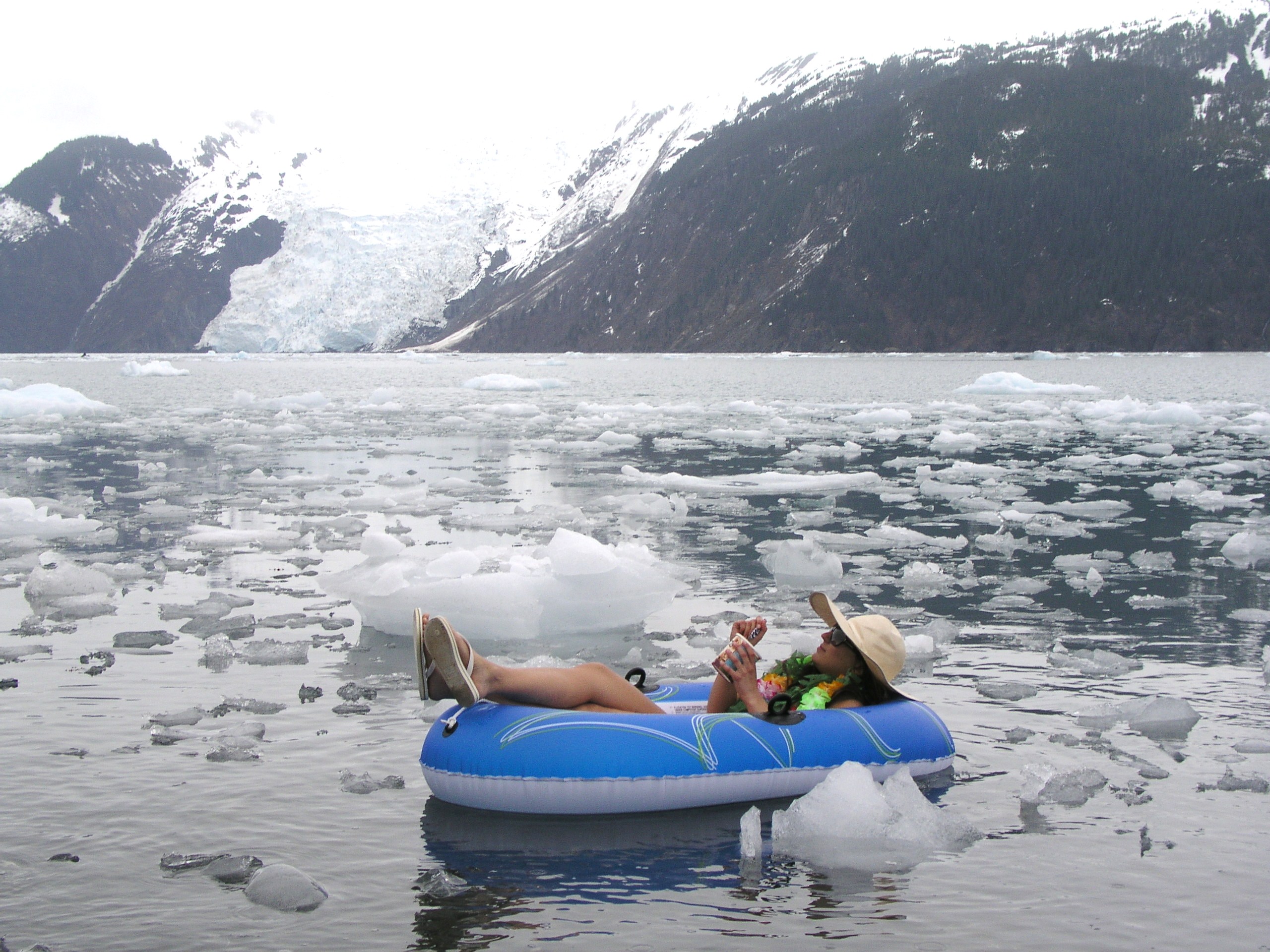
Soon no longer just fiction? (I.Quaile, Alaska)
When the talks started in Bonn on Monday, a preparatory meeting for this year’s climate mega-event, also to be held here this November at the headquarters of the UNFCCC, people were anxiously awaiting a meeting that was still scheduled to take place in the USA on Tuesday, when the President was to make the decision on the Paris Agreement. It has since been postponed. The fact that it has been rescheduled until after the G7 meeting later this month, which will be attended by President Trump, supports the view that there is more to this than just a collision of appointments. Paula Caballero, the Global Director of the Climate Program at the World Resources Institute WRI, is in Bonn for the talks, and she told me in an interview the US Cabinet is divided on this issue and President Trump still has to make up his mind. She is hopeful that good (business) sense will prevail and President Trump will be influenced by those – in his immediate surroundings and on the international stage – who point out it makes sense from all points of view to stay in that Agreement and promote the shift to renewable energies and emissions reductions. Will the G7 meeting convince Trump to stay in the Paris Agreement?
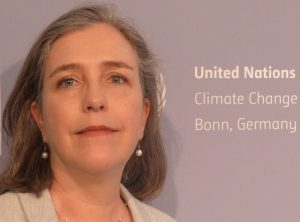
Caballero says it’s in everybody’s interests for the US to stick with Paris. (Pic. I.Quaile, Bonn)
Energy revolution from the bottom up?
You can read that interview, in which Ms Caballero outlines the ins- and outs of the US-Paris Agreement decision and stresses why it is in everybody’s interests for the US to stay in – on the DW website, or listen to it in the latest edition of Living Planet. One thing that is clear is that the momentum of the shift to renewable energies is picking up across the globe, regardless of the attempted rollback in the USA.
On Living Planet I also talk to two women in the programme who are pushing ahead with climate protection at the city level. Laura Kavanaugh and Maryke Van Staden work with ICLEI, a worldwide alliance of “local governments for sustainability”, which held a “Resilient Cities” forum, also here in Bonn, last week. Their message is quite clear. Cities around the globe are already feeling the impact of climate change now. Urgent action is required. The same is true of the Arctic, which is being hit so much harder and faster than the rest of the planet by climate warming.
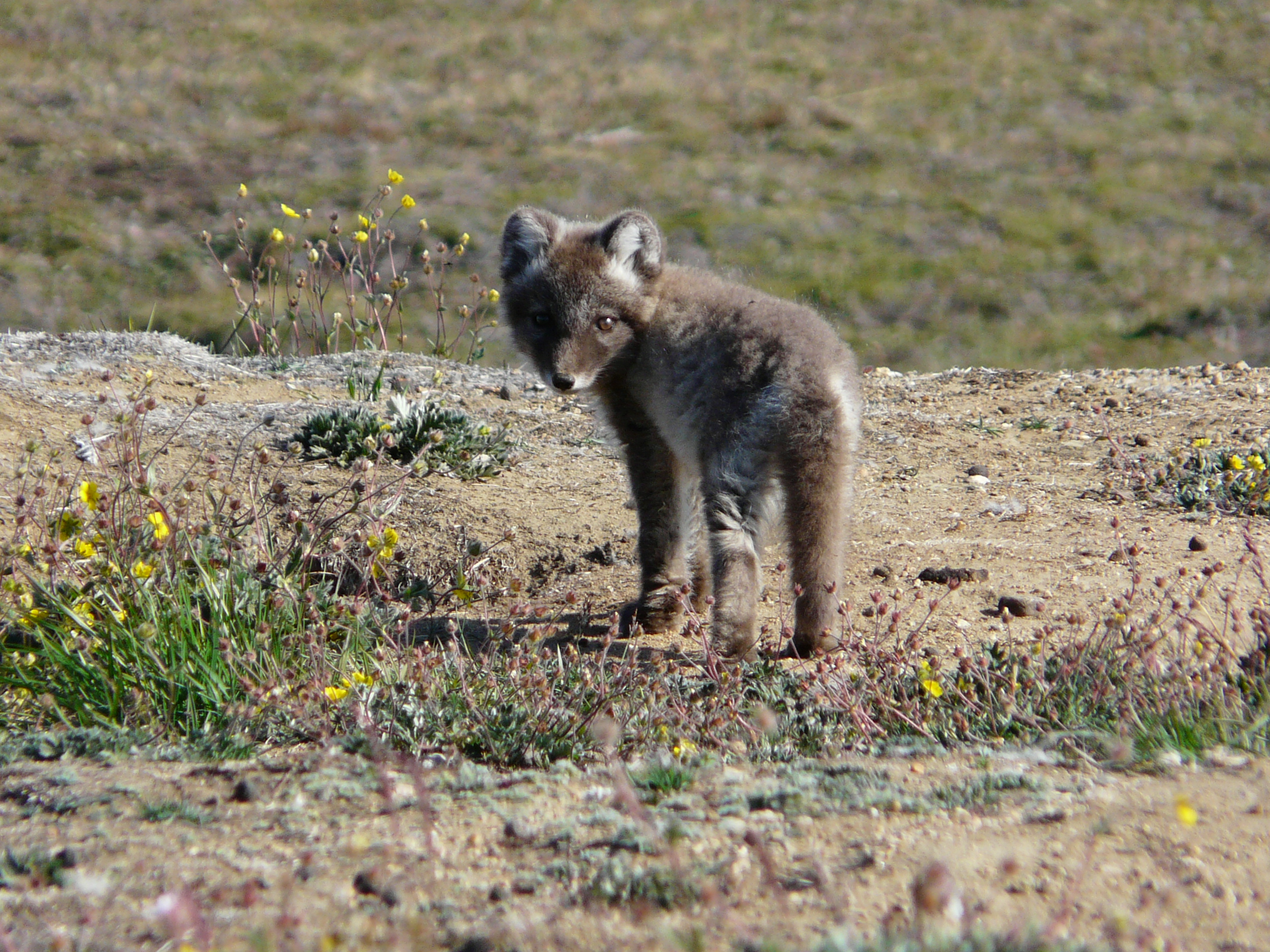
Will the Arctic fox survive in a warming climate? (Pic. I.Quaile, Greenland)
Ulterior motives
Clearly, progress to halt global warming is key to preserving the Arctic ice. That makes it all the more interesting that the Arctic Council summit in Fairbanks is being hosted by none other than the “new” US Secretary of State Rex Tillerson, as the USA has held the rotating Chairmanship of the Council for the last two years. Given that Tillerson is former CEO of the fossil fuels giant EXXON Mobil, there will be a keen interest in anything he says on or off the record, with regard to climate change and the prospect of future oil and gas drilling in the Arctic. Given that he is the first Republican Secretary of State to attend an Arctic Council summit, unsurprisingly there is much speculation about whether this indicates an increased US interest in the Arctic – and with what motives. Joel Plouffe has some interesting insights on that aspect.
The Trump administration is keen to boost Arctic drilling, hoping to benefit from easier access thanks to Arctic warming and decreasing sea ice cover. It is to be feared that this is the main reason for the upsurge in US interest in the region. The same applies to Russia.
The thing is, Lavrov didn't have to be there. The other #Arctic FMs weren't there. Just him, watching Tillerson's 2 min welcoming remarks. ? https://t.co/qeEdLGTWRg
— Heather Exner-Pirot (@ExnerPirot) May 11, 2017
Heather Exner-Poirot notes with interest that Russian foreign minister Sergei Lavrov was the only one of the Arctic foreign ministers to hear Tillerson’s speech at the reception in Fairbanks on Wednesday evening.
Cooperation – on climate science?
Finland will take over the helm of the Arctic organization at the end of today’s meeting. Finland has said it aims to protect the Arctic during its chairmanship by adhering to the Paris Agreement. Good luck Finland. You have an interesting couple of years ahead of you.
The theme of the US Chairmanship has been “One Arctic: Shared Opportunities, Challenges and Responsibilities”. The Council says this was reflected in much of the work completed by its six Working Groups and Task Forces over the last two years.
One key issue in focus is science. The “Agreement on Enhancing International Arctic Scientific Cooperation” is up for approval and signature in Fairbanks.
Since taking office, the Trump administration has taken drastic measures to cut budgets for climate science and environment protection. Not without reason did scientists takes to the streets around the world in protest. So there was a considerable feeling of relief when David Balton, the State Department’s assistant secretary for oceans and international environmental and scientific affairs and chair of the Senior Arctic Officials over the past two years announced on Monday that the US remained commited to Arctic climate change research.
“The US will remain engaged in the work the Arctic Council does on climate change throughout,” he told reporters.
“I am very confident there will be no change in that regard”.
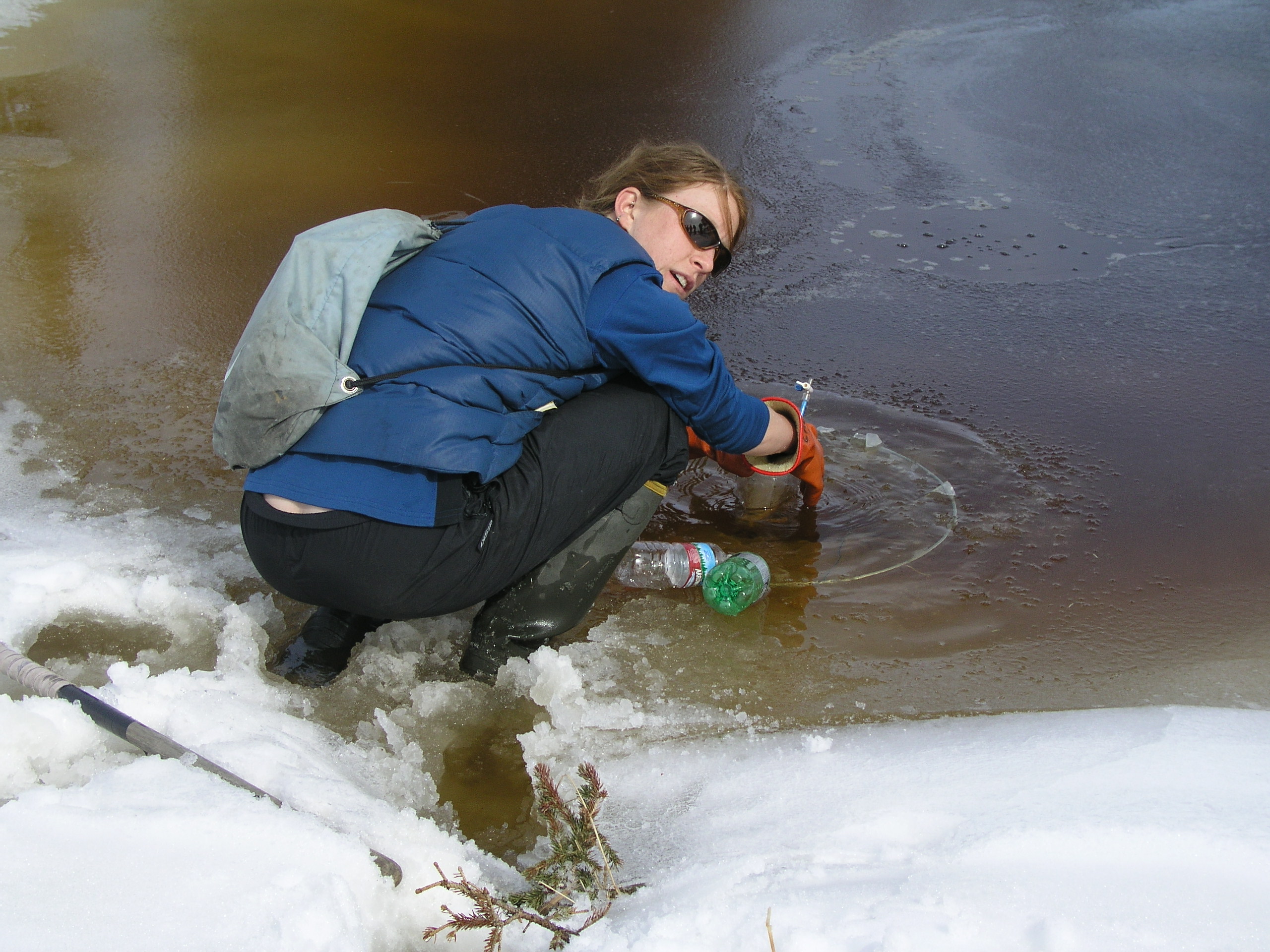
Scientific research is key. Collecting methane from melting lake in Alaska (Pic. I.Quaile)
To drill or not to drill…
It remains to be seen exactly what that will involve. It is hard to understand how Trump’s considering pulling the US out of the Paris Agreement can be reconciled with any commitment to protecting the Arctic from climate warming. It seems more likely that he is keen to benefit from the effects of climate change making the Arctic more accessible for commercial development. After all, scientific research in the Arctic can take many forms.
On April 27, the President signed an executive order aimed at rolling back restrictions on offshore drilling, including offshore Alaska. Barack Obama had issued orders closing off areas of the Arctic and Atlantic oceans to oil and gas drilling.
In the meantime, ten environmental and Alaska Native groups are suing the federal government over Trump’s new order. The groups are led by the League of Conservation Voters, Natural Resources Defense Council and Earthjustice. They say the order exceeded Trump’s authority under federal law.
In ADN, on May 3 Erica Martinson quotes Niel Lawrence, NRDC senior attorney:
“These areas have been permanently protected from the dangers of oil and gas development. President Trump may wish to undo that, and declare our coasts open for business to dirty energy companies, but he simply lacks the authority to do so under the law.”
Icy battle over future energy
While the legal wrangling continues – and the number of lawsuits involving climate change is on the increase – the Arctic continues to warm at a rapid rate.
The “Snow, Water, Ice and Permafrost in the Arctic” (SWIPA) report published in April indicates that the Arctic Ocean could be largely free of sea ice in summer in just two decades, and that projections of global sea level rise are underestimated.
The signs do not bode well for the Arctic. What happens in the region depends very largely on how fast the world is able to halt global warming. With the world’s second-biggest emitter set on exploiting the impacts of global warming in the region and reversing measures to protect environment and climate, the main question is how much influence the USA will actually have, and how resilient the transition to renewable energies will be.
Claudia Kemfert, a leading climate economist, recently published a new book in German about what she sees as the fossil fuels empire “striking back”, a campaign to discredit the green energy revolution. She warns against complacency and underestimating the influence of the fossil fuels lobby.
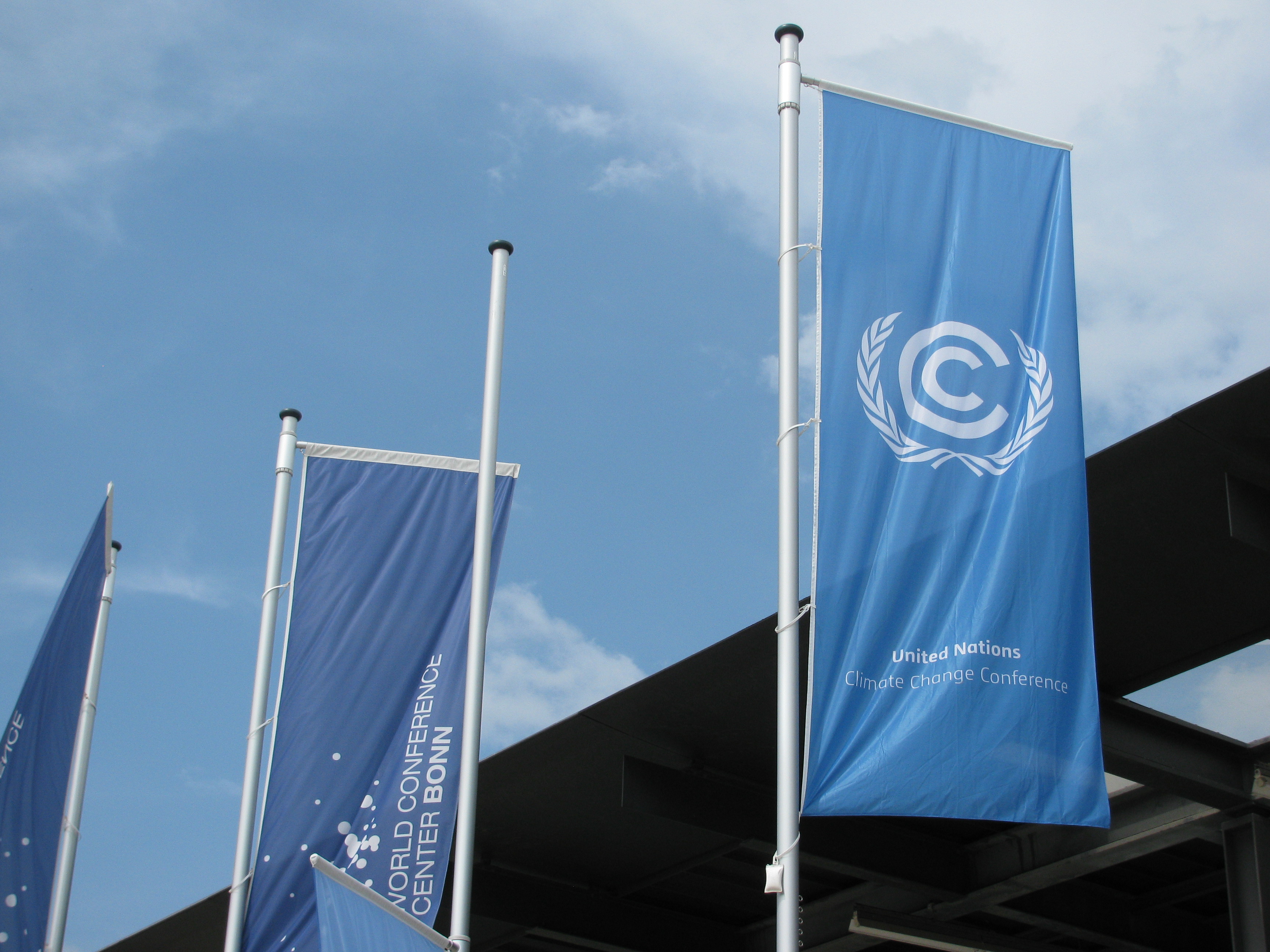
Bonn hosts the UN climate talks now and in November (Pic: I.Quaile)
At the UN talks in Bonn, the influence of those fossil fuel lobbyists on the negotiations has become a key topic of debate.
Government representatives with the common goal of achieving climate protection are not the only ones attending the talks. Alongside the environmental activists on the sidelines, lobbyists from various sectors are also there to promote their own interests. And these include industries which do not stand to profit from restrictions on emissions. All these groups are allowed to attend the international climate conferences hosted by the United Nations Framework Convention on Climate Change (UNFCCC).
Transparency needed
A recently published report from Corporate Accountability International, a United States-based nongovernmental organization, highlighted the strong power of trade and business organizations at climate-related events.
The fossil fuel industry is particularly well represented.
One group cited in the report is the National Mining Association in the US, which, the ngo notes, supports increased coal consumption and contributes to climate change.
The United States Chamber of Commerce is another regular participant. The largest lobbying group in the country – and the largest chamber of commerce in the world – is in favour of nuclear power, offshore oil production and drilling in the Arctic National Wildlife Refuge.
When it comes to the Arctic, the stakes have never been higher, politically, economically and of course environmentally.
Even the implementation of the most ambitious emissions reduction measures will not halt the increasing accessibility of the once virtually unnavigable Arctic Ocean in the near future. That guarantees that this will not be the last Arctic meeting to be attended by top-level politicians from the world’s most powerful nations. Meanwhile, the lobbyists will continue their attempts to prolong the fossil fuels era in spite of all the scientific evidence indicating the dangers it holds for the planet.
Perhaps the most important thing about Tillerson’s attendance in Fairbanks is the attention it draws to what is happening in the high north. And the UN climate process can only benefit from the transparency emerging over exactly who is advocating and influencing what in the negotiations.
Cheap oil from the Arctic? Fake news, says climate economist Kemfert
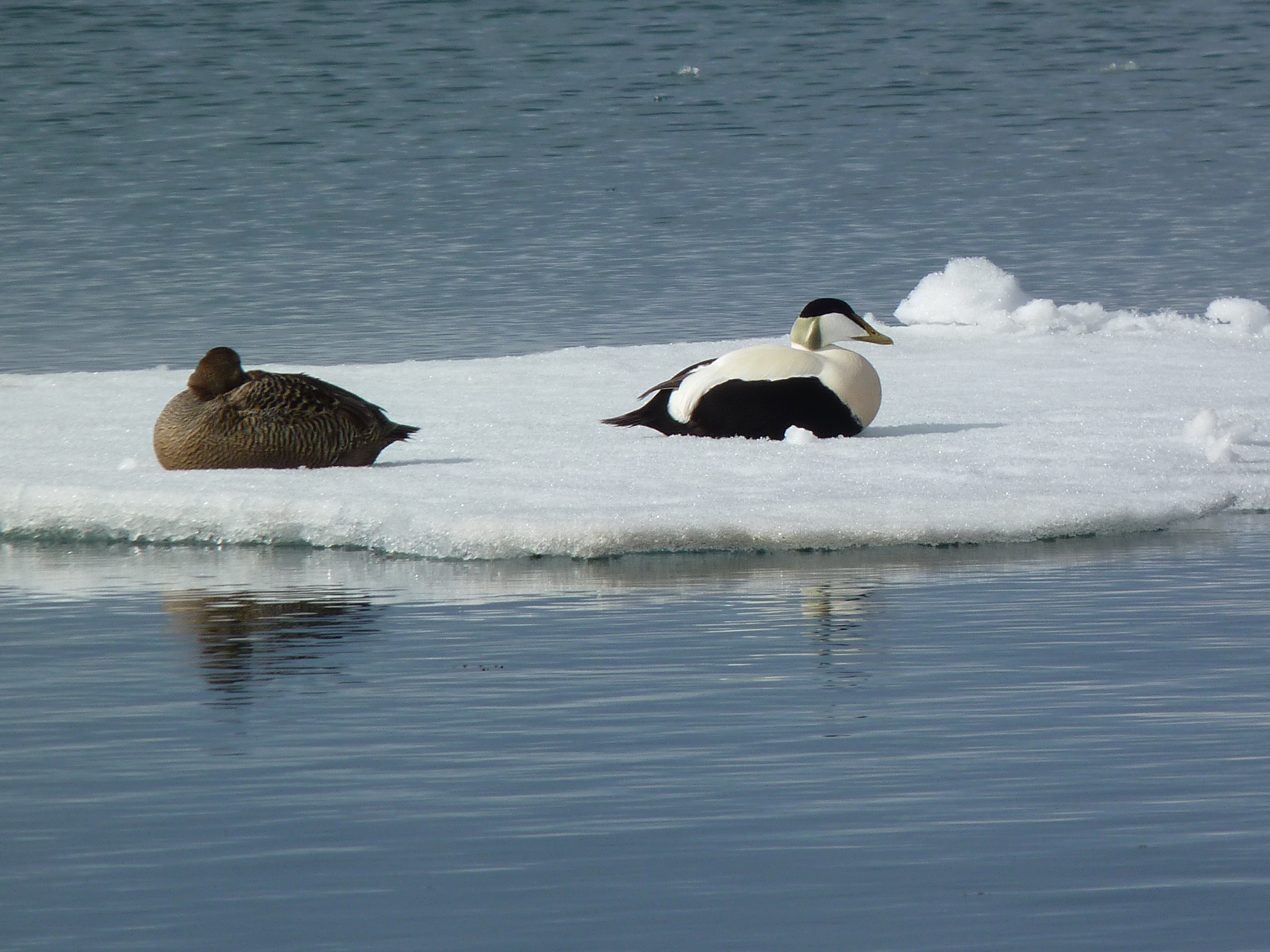
Nothing fake about melting ice. Eiders, off Svalbard (I.Quaile).
This week I came across an interesting publication about to come on to the German market.
“The fossil empire strikes back” (Das fossile Imperium schlägt zurück) is the translation of the catchy title of a new book in German by Professor Claudia Kemfert, head of the department of energy, transportation and environment at the German Institute for Economic Research in Berlin (DIW Berlin,) and professor of energy and sustainability at the Hertie School of Governance, in Berlin.
She has also acted as advisor to the German government, the European Commission and is on the steering committee of the renowned Club of Rome.
A fossil fuels revival: happening now, or alternative facts?
I called her up to record an interview for our Living Planet radio show to find out what was behind the headline, and the sub-title: “why we have to defend the “Energiewende” (energy transition) now.
Prof Kemfert believes the fossil fuels sector is really working hard at making a comeback. That, she says, is not fake news, but the fossils lobby makes use of the latter in its attempt to turn the clock back in terms of energy production.

Kemfert argues for renewables. Copyright: Neuberg, Sebastian Wiegand
While the global transition towards renewable energy has been successful in recent years, with the costs of alternative energies reduced, the Paris Agreement signed and ratified, now, she says, the fossil fuels sector is striking back.
She says they do it by spreading fake news, creating myths about restrictions on cars, speed limits, blackouts, globally, but especially in the USA under the Trump administration. So, she argues, we have to defend the energy transformation. The window of opportunity for climate action is still open, but we are losing time.
The power of fake news
Kemfert’s aim is to debunk the myths, which she is convinced are being used to give renewable energy a bad image. Some of the examples she cited to me are false claims that renewables are more expensive, or that reliance on alternative energies will mean blackouts.
“This has never happened in Germany”, she notes, the country that gave the “Energiewende” its name and pressed ahead with the transition to renewables in recent years.
So how can fake news of this kind make such an impact that Kemfert and other like-minded experts are worried about an oil and coal revival?
“If you repeat this all the time, and repeat it on social media, people think it’s true”, she told me.
“The danger is that they can be successful”.
“The global energy transition is in danger”, she is convinced. “We are losing time to bring greenhouse gases down and help the planet to survive.
“The lobby of the fossil empire is extremely strong… the whole campaign with myths and fake news is really successful, because a lot of people believe what they say”.
So are the fossil fuel lobbyists just better at getting a message across than the other side? There could be something to that, Kemfert agreed. She says the “green lobby” is not aggressive enough. People think “we are the good ones, the energy transition comes by itself”- this is not true. Now it’s time to fight for it”.

We still have a window of opportunity, says Kemfert (Pic. I.Quaile, Alaska)
Time to march?
She calls on all scientists and people who want to protect free and democratic science, to take part in the Marches for Science, planned to take place round the globe on April 22nd.
Of course I wanted to know how she thought the global counter-attack by the “fossil empire” would impact the Arctic.
Yes, she said, this push for a fossil fuels revival could provide additional motivation to those who would like to push ahead with Arctic drilling, as climate change makes for easier and less expensive access:
“There are some aggressive industries, especially coming from the oil and gas sector, who have interest to drill for oil in the Arctic region.
For them, she says, easier access thanks to climate change would be “a nice, so-to-say side effect”.
But for the planet as a whole, climate change is so dangerous that any potential short-time business benefits are just not worth thinking about, says Claudia Kemfert:
“As a climate economist, I cannot say this (oil from the Arctic) makes economic sense, because the costs of climate change are much higher than lower costs, for example, for drilling oil in the Arctic. The costs of global climate change are so high that it cannot outweigh the cost reduction of oil drilling in the Arctic when there’s low ice. We have to move away from oil and gas, this is why it’s more economically efficient to go for an energy transition instead of drilling in areas where we have climate impacts, we are causing environmental difficulties and where we know that burning these fossil fuels will create climate change. That’s really the wrong way to go”.
Kemfert’s book is only being published in German at the moment, but there is more info on her home page, and a longer version of the English interview I conducted with her will be coming up soon on Living Planet and on the DW website.
Arctic sea ice: is the minimum maximum the new normal?
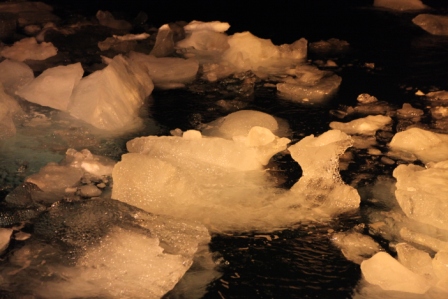
Even the winter sea ice is waning (Off Svalbard, pic. I.Quaile)
If you blinked, you might have missed it. The confirmation came this week that the Arctic sea ice reached yet another all-time low this past winter. It came and went, without too much ado.
Maybe the excitement was just past. The maximum extent was actually reached on March 7th, but of course you can only be sure it is really not going to spread any further once it has definitely been retreating for some time with the onset of spring.
I was waiting for the NSIDC confirmation, but not with any doubt in my mind that it would tell us officially the maximum for this season would be a minimum.
The danger is a “so what?” kind of reaction, or resignation, with the feeling that nothing short of some kind of unprecedented experimental geo-engineering could save the Arctic summer sea ice in the coming years, as the world continues to warm.
Lowest on record
The National Snow and Ice Data Center (NSIDC), part of the Cooperative Institute for Research in Environmental Sciences at the University of Colorado Boulder, and NASA confirmed this week that Arctic sea ice was at a record low maximum extent for the third straight year.
It reached the maximum on March 7, at 14.42 million square kilometers (5.57 milion square miles). Since then, it has started its annual decline with the start of the melt season. Some time in September it will reach its minimum.

Sea ice going, going, gone? (Photo: I Quaile, off Svalbard)
This year’s maximum is the lowest in the 38-year satellite record. NSIDC scientists said a very warm autumn and winter had contributed to the record low maximum. Air temperatures were 2.5 degrees Celsius (4.5 degrees Fahrenheit) above average over the Arctic Ocean. Against the background of overall warmth came a series of “extreme winter heat waves over the Arctic Ocean, continuing the pattern also seen in the winter of 2015”, NISDC said in a statement.
The air over the Chukchi Sea northwest of Alaska and the Barents Sea north of Scandinavia was even warmer, averaging around 9 degrees Fahrenheit (five degrees C) above the norm.
NSIDC director Mark Serreze said in his statement: “I have been looking at Arctic weather patterns for 35 years and have never seen anything close to what we’ve experienced these past two winters.”
The winter ice cover was also slightly thinner than that of the past four years, according to data from the European Space Agency’s CryoSat-2 satellite. Data from the University of Washington’s Pan-Arctic Ice Ocean Modeling and Assimiliation System also showed that the ice volume was unusually low for this time of year.
Record summer melt ahead?
“Thin ice and beset by warm weather – not a good way to begin the melt season,”, said NSIDC lead scientist Ted Scambos.
A low maximum does not necessarily mean the minimum to be measured in September will also be a record low, as it depends on summer weather patterns. But Julienne Stroeve from NSIDC and professor of polar observation and modeling at the University College London said “Such thin ice going into the melt season sets us up for the possibility of record low sea ice conditions this September”.
“While the Arctic maximum is not as important as the seasonal minimum, the long-term decline is a clear indicator of climate change”, said Walt Meier, a scientist at the NASA Goddard Space Flight Center Cryospheric Sciences Laboratory and an affiliate scientist at NSIDC. Iceblog readers might wonder if that is stating the obvious, but given the attitudes of the US administration, you can’t take anything for granted.

Data from satellites is key. Reception centre at KSAT in Tromso, Norway, Pic. I Quaile)
The September sea ice measurements began to attract attention in 2005, when the ice extent first shrank to a record low over the period of satellite observations. It broke the record again in 2007 and in 2012. There used to be little interest in the maximum extent of the Arctic sea ice at the end of winter. I can remember reading with concern and writing a piece about the maximum extent also reaching a record low in 2015.
NOAA (climate.gov, “science & information for a climate-smart nation”!) said in its statement:
“Arctic sea ice extents have followed a steady downward trajectory since the start of the 21st century – at the same time global temperatures have reached new record highs. Betides setting multiple record low summertime minimum extents, Arctic sea ice began to exhibit a pattern of poor winter recovery starting around 2004.”
Living on thin ice
I remember an expedition to Alaska in 2008, when locals at Barrow told me about their personal experiences of the sea ice becoming thinner and less dependable. Some years later I heard similar reports from people in Greenland, who were selling their sled dogs and buying boats in preparation for changing from ice to open water fishing. The data backs them up.

Sled dog – out of work? (I.Quaile, Greenland)
Yereth Rosen, writing for Alaska Dispatch News, draws attention to the problems of continuing to collect that data. She quotes NSIDC’s Serreze:
“Just how well the center will be able to track sea ice in the future remains unclear. No new satellite is expected to be in place until 2020, and there are concerns about potential interruptions in the record that goes back to 1979… We’re at a situation where the remaining passive microwave instruments up there are kind of elderly. If we have satellite failures, we could lose that eye in the sky”.
Now there is a worrying thought.
Against the background of budget cuts proposed by the Trump administration, that – to put it mildly – does not regard tracking climate change as a high priority – scientists are understandably worried about the future of scientific research on climate and environment related issues.
Method in the madness?
Without reliable continuous satellite data, it would be much harder to track how climate change is affecting the polar regions, the ocean and our planet in general. This may well be the intention of climate-change deniers behind the scenes. But climate change itself will not go away – and the impacts will be increasingly evident.
Tim Ellis, writing for Alaska Public media, quotes Serreze as saying the polar ice cap will not last long if the region continues to warm at this rate.
“We are on course sometime in the next few decades, maybe even earlier, to have summers in the Arctic where, you go up there at the end of August, say, and there’s no ice at all.”
“The view from space in the fall of around 2040” , he went on – assuming we still have satellites to take the pictures – “will be of a blue Arctic Ocean, aside from some scattered icebergs and clusters of pack ice”.
I don’t know about you, but I find that a rather depressing thought.

My kind of sea ice – frozen Chukchi Sea (Pic: I.Quaile)
Implications for the rest of the globe
Andrea Thompson, for Climate Central, writes “even in the context of the decades of greenhouse gas-driven warming, and subsequent ice loss in the Arctic, this winter’s weather stood out.”
She also reminds us of the global impacts of a warming Arctic and decline in sea ice:
“The Arctic was one of the clear global hotspots that helped drive global temperatures to the second- hottest February on record and the third-hottest January, despite the demise of a global heat-boosting El Nino last summer.”
This week the UN’s World Meteorological Organisation (WMO) said 2016 had been the hottest year ever recorded, and that the record-breaking heat had continued into 2017, sending the world into “truly uncharted territory”.
“The dramatic melting of Arctic ice is already driving extreme weather that affects hundreds of millions of people across North America, Europe and Asia, according to emerging research”, Damian Carrington writes in the Guardian.
On March 15th, Carrington published an article entitled “Airpocalypse smog events linked to global warming”, referring to extreme smog occurrences in China.
Optimism – the only way to go?
This week I interviewed German oceanologist and climatologist Mojib Latif. I wanted to find out whether the highly unusual extreme rainfall and flooding happening in Peru could be explained by natural cycles or was likely to be a climate change impact which could reoccur. You can read the interview here or listen to it on my Living Planet show this week online or on soundcloud.
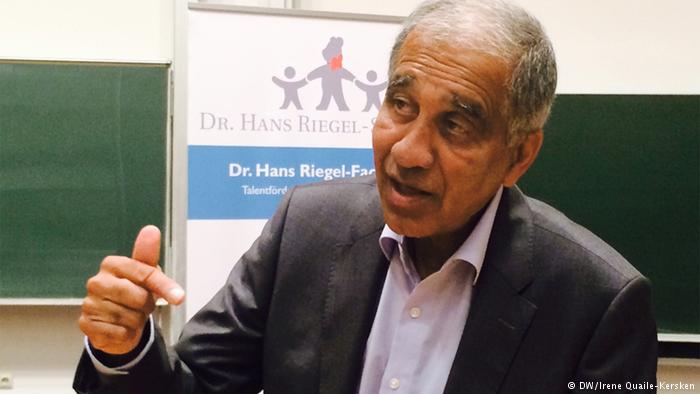
Professor Latif on a visit to Bonn. (Pic. I.Quaile)
The professor stressed that the scientists are baffled, because it is not really the time for an el Nino, although this seems to be a “coastal el Nino”, driven by exceptionally warm water off the coast. Of course he is reluctant to attribute any single event to climate change. He stated unequivocally, though, that the warming of the ocean worldwide was absolutely inexplicable without anthropogenic CO2 emissions, that this is all in line with climate models and that we should all be preparing for an increasing number of increasingly extreme weather events, as the world warms.
He says the governments of the world (apart perhaps from the new US administration) are in no doubt that climate change is happening and they need to halt it. But they have so far failed in their attempts.
When I asked Professor Latif if he still felt optimistic, he told me we really had no other choice. While critical of the lack of government action, he is convinced the world will realize that renewables are ultimately far superior to fossil fuels and will ultimately prevail. The question is whether that will happen in time. As far as the Arctic summer sea ice is concerned, I have to go with a Scots expression: “A hae ma doots”.
Arctic summer sea ice cover could disappear with 2C temperature rise

The sea ice has been dwindling for decades (Photo: I Quaile)
The Arctic sea ice may disappear completely in summers this century, even if the world keeps to the Paris Agreement. That is the worrying message of a report published on Monday in the journal Nature Climate Change.
The 2015 Paris Agreement set a goal of limiting the rise in global temperature to well below two degrees Celsius (3.6 Fahrenheit) above pre-industrial times. Ideally, 1.5C (2.7F) was agreed to be the “aspirational” target. James Screen and Daniel Williamson of Exeter University in the UK, wrote, after a statistical review of ice projections, that a two degree Celsius rise would still mean a 39 percent risk that ice would disappear from the Arctic Ocean in summers. If warming is kept to 1.5 degrees Celsius, the ice was virtually certain to survive, they calculated.
Current emissions targets way too low

Looking to an uncertain future. Svalbard polar bear. (Pic. I.Quaile)
If you take the old “glass being half-full rather than half-empty” metaphor, you could see that as a positive option to hang on to. However, the scientists estimated that if we continue along current trends, temperatures will rise by three degrees C (5.4 F.). That would give a 73 percent probability that the ice would disappear in summer. To prevent it, governments would have to up their targets and make considerably larger cuts in emissions than presently planned.
The sea ice will reach its maximum winter extent some time soon. So far, the March figures rival 2016 and 2015 as the smallest for the time of year since satellite records began in the late 1970s.
“In less than 40 years, we have almost halved the summer sea ice cover”, Tor Eldevik, a professor at the Bjerknes Centre for Climate Research at the University of Bergen in Norway, told Reuters. Eldevik was not involved in the study.
He predicted that sea ice would vanish in the Arctic Ocean in about another 40 years, on current trends.
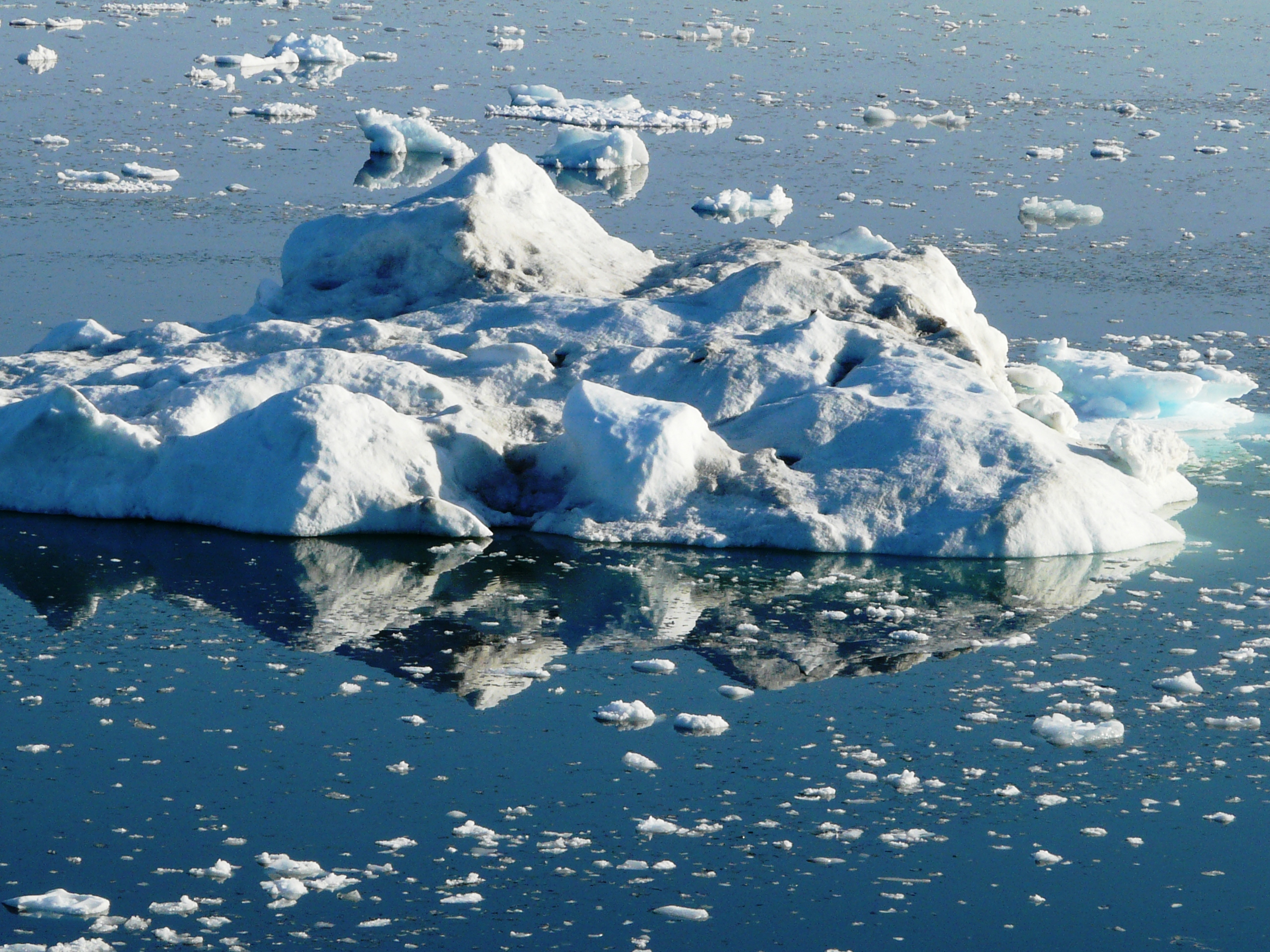
… And the ice just keeps on melting. (Pic: I. Quaile,) Greenland)
Steady melting trend
Scientists define an ice-free Arctic Ocean as one with less than one million square kilometers (386,000 square miles) of ice, because they say some sea ice will linger in bays, for instance off northern Greenland, even after the ocean is ice-free.
Despite fluctuations from year to year, long-term trends in the Arctic clearly show a decline in sea ice. The ten lowest ice extents since 1979 have all occurred since 2007.
According to the latest figures from the NSIDC (March 6), high air temperatures observed over the Barents and Kara Seas for much of this past winter moderated in February. Still, overall, the Arctic remained warmer than average and sea ice extent remained at record low levels.
Arctic sea ice extent for February 2017 averaged 14.28 million square kilometers (5.51 million square miles), the lowest February extent in the 38-year satellite record. This is 40,000 square kilometers (15,400 square miles) below February 2016, the previous lowest extent for the month, and 1.18 million square kilometers (455,600 square miles) below the February 1981 to 2010 long term average.
Good times ahead for Arctic shipping, trade and tourism? Not much of a future for polar bears struggling for survival, or for people whose livelihood and way of life depends on reliable ice cover.




















Feedback